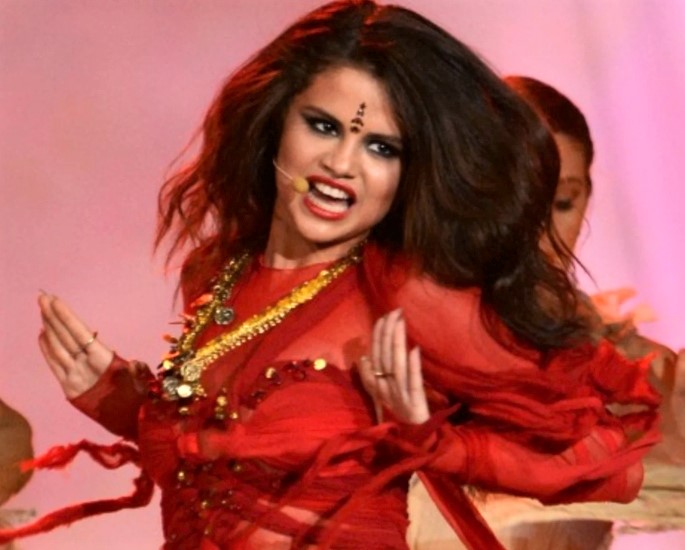"It is not meant to be thrown around loosely for seductive effects"
Cultural appropriation in music is an issue commonly bought to light. From runways to musicians, the disregard towards cultures is becoming an increasing concern.
Ruka Hatua-Saar White, an assistant professor of dance at Berklee College outlined cultural appropriation as:
“The adoption of an element or elements of one culture by members of another culture.
“This can be controversial when members of a dominant culture appropriate from disadvantaged minority cultures.”
This kind of appropriation is mostly seen through the form of fashion. Famously, celebrities like Kim Kardashian have come under fire for their uncommon outfit choices.
However, this has infiltrated the music industry. Singers like Selena Gomez and Lady Gaga have faced backlash for appropriating South Asian garments.
Therefore, wearing cultural designs for aesthetics is facing wide criticism, especially due to its overhaul amongst musicians.
Using specific examples from accessories to hairstyles, cultural appropriation is heightening cultural insensitivity.
Fans have an increasing awareness of this offence, making it a key downfall of this industry, but to what extent?
Where is Cultural Appropriation most Evident?

Cultural appropriation is cropping up all over the music industry. From the western world of music to Korean pop (K-Pop), it is becoming a key instigator for cultural insensitivity.
Interestingly cultural appropriation is not even a new happening. For example, singer Gwen Stefani was formidable for wearing bindis and Indian outfits during the 80s and 90s.
Although, she remains adamant that this was a form of cultural appreciation rather than appropriation.
In 2013, American singer Selena Gomez became engulfed by controversy.
At the 2013 MTV Movie Awards, the starlet performed magically on stage. However, issues arose due to her Desi outfit, which included a bindi.
Bindis are a common accessory amongst South Asians and have spiritual and religious connotations attached to them.
By wearing one during a sultry performance of her smash hit ‘Come & Get It’ (2013), Gomez was criticised for ignoring its cultural importance.
Rajan Zed, a Hindu cleric, reacted to the performance. He personified the anger of fans and viewers, revealing the value of a bindi:
“It is not meant to be thrown around loosely for seductive effects or as a fashion accessory aiming at mercantile greed.”
Gomez defended herself against the backlash and said:
“The song kind of has that almost Hindu feel, that tribal feel. I kind of wanted to translate that.”
Additionally, prominent musicians such as Miley Cyrus and Iggy Azaela have also worn the symbolic accessory.
But it is not just the western world that has seen this issue flood its stages. For many K-Pop fans, cultural appropriation is becoming a dreaded reoccurrence.

Popular girl groups such as BLACKPINK to (G)I-DLE have all been called out by fans for their appropriation.
In June 2020, BLACKPINK released their track ‘How You Like That’. Signalling their comeback, thousands of fans were left ecstatic.
However, they soon received criticism for using a Hindu sculpture in the music video. The statue had nothing to do with the song or the culture and was purely used as a prop for aesthetic purposes.
Even earlier in 2017, iconic star Lee Hyo Ri was scrutinised for her song ‘White Snake’.
The hit included a verse of a Sanskrit chant associated with purity. So, when Ri performed a seductive sequence to it, South Asian fans were furious. Mariam Rahimi, a K-Pop fan, revealed:
“K-Pop idols often, in my opinion, don’t always have a bad intention when culturally appropriating, and are highly uneducated on how to wear things or when to wear things.”
She goes on to detail the issue with this:
“[Cultural appropriation] is a real problem if you are going to profit off these aesthetics.”
Likewise, Shreya Juyal, a student at the University of Delhi and an avid follower of K-Pop declared:
“The problem is that the same people who scorn at Indians smelling like curry turn around and use bindis, maang tikas, and bangles.
“[They use] mudras for their dance steps, because it’s ‘ethnic and hip’.”
Though, it is important to recognise that cultural appropriation happens in other areas.
Wherever there are lights, cameras and action, you can assume that a ‘bold’ fashion choice will draw attention.
Kim Kardashian is a name known worldwide. It’s undeniable that she holds a lot of power, whether that is via wealth or her media influence.
Therefore, when the reality-television star posted a picture wearing a maang tikka, it caused huge controversy.
Followers exposed their distaste at Kardashian. Many expressed that she wore enriching South Asianwear without acknowledging the source.
Nevertheless, in the digital age, artists and influencers issue apologies like clockwork. From Instagram posts to the criticised YouTube apology videos, quick responses to backlash are no longer rare.
But is it genuine? Was it their fault? It’s often left up to the interpretation of music fans.
Cultural Appropriation – What’s the Problem?

Many may wonder what the issue is with cultural appropriation. Isn’t wearing items belonging to another culture an appreciation of it? Are we taking this matter too seriously?
Whilst many may defend the artists who are negligent to cultures, the question of being appreciative still causes confusion.
Cultural appreciation is based on trying to understand the culture you are immersing yourself in. You explore the culture, educate yourself about it and understand the significance of the style, item or object.
On the other hand, cultural appropriation is often embracing something for the profit and style factor.
Players in the music industry often refer to or utilise cultures, but often mix them together too. This can lead to a misunderstanding of values.
A collaboration that illustrated this to great extent was Coldplay and Beyonce’s song ‘Hymn for the Weekend’ (2016). The smash-hit, which has over 1 billion YouTube views has been a conflicting topic for its music video.
It played its part in a system that represents how the west understands and engages with the world.
Rashmee Kumar, a writer for The Guardian explained that this means the modern world has idealised places like India:
“India is a lush, exotic land filled with dingy slums inhabited by pious, levitating holy men and lanky brown-skinned children who are always throwing colored powders at each other.”
He later illustrates the devastation of this:
“These tropes of colours and spirituality and poverty have been reproduced so often by western media.
“They’ve become inherent to what India means in our collective imaginations.”
The backlash was widespread on social media, especially on Twitter with one user voicing:
@coldplay don't exoticize us. You've been to the clubs and everything.Why do you want to make it seem like all we do is dance in the streets
— r (@BiryaniZiall) January 29, 2016
This shows that the music industry gives an outdated view of what South Asian countries are about.
Of course, there is a place to showcase cultural festivities. But, fans are more concerned with artists who do not expose the modernisation of such countries.
Furthermore, if an artist, with a big following, projects an uneducated cultural message, this relays inaccurate thoughts around the culture.
Kirsten Louise, a student from the West Midlands, addressed this further:
“It doesn’t educate people well and leads to very important and symbolic things being done carelessly.”
Additionally, Major Lazer and DJ Snake reinforced this carelessness. In their 2015 music video for ‘Lean On’, they unconsciously endorsed an idea of supremacy – a fragile topic within the modern world.
The song which included Danish singer, MØ, was successful but oozed with cultural appropriation.
The Bollywood design, Desi dancers and exotic location were vibrant yet the song has nothing to do with this.
Also, scenes such as the performers dancing around the main artists of the song were uncomfortable for some.
In a blog post, Sam Faye expressed the torment this could cause South Asian viewers:
“This created a very uncomfortable ‘master’/’slave’ perceived dichotomy where the ‘native people’ danced around white people as entertainment in a servile manner.”
Finally, cultural appropriation is simply offensive to fans. Seeing your favourite musicians ignore the importance of your culture is not easy.
For many, it undermines one’s interest in an artist if they cannot understand the true meaning of something they wear or do.
It can make people feel ostracised by an artist. Especially with the growing popularity of streaming and visual art, more young and impressionable fans will carry on these outdated perceptions.
If someone mocks your culture, how long would you stand around to watch?
The Downfall of Music?

As briefly mentioned, fans of various musicians are becoming more aware of this pressing issue.
Young people are increasingly involved in the act of holding these performers accountable, especially across social media.
Living in an interconnected world has allowed the understanding of different cultures to spread quickly. This has welcomed the moral respect of cultures to thrive in the western world.
That’s why we can quickly spot issues with cultural appropriation. For example, in 2010, Katy Perry married Russel Brand in India with a Bollywood-themed party and baarat (South Asian procession).
Although this is not entirely musically related, the fact neither celebrities follow the religions or culture of India emphasised their obliviousness.
Music artist and producer Pharrell suffered backlash for his Holi inspired trainer collaboration with Adidas in 2018.
The music industry highly respects these formidable musicians. They’ve obtained millions of fans, some of whom are die-hard followers.
So, their every move influences thousands. If they use cultures for financial gain, they expose their listeners to a culture that they know nothing about.
Furthermore, artists and their music videos are prime examples of this. They present ideologies and aesthetics from South Asia but present them in a ‘new’ and ‘fashionable way’.
It suggests to their fans that these artistic themes are innovative without delving into where they originate from.
Ruka Hatua-Saar White words it perfectly:
“Consider listening to and sharing the music of historically excluded artists who identify with the culture from which you wish to borrow.”
Mariam Rahimi also comments:
“Cultural appropriation is like a blissful ignorance that needs to be addressed.”
The quicker we understand that something is wrong, the more likely we are to spread awareness of it and condemn the wrong-doers.
The baseless fashion aesthetics that musicians promote is a toxic cycle. In addition, we need to understand the way that the music industry advances cultural appropriation.
Popular music figures are glamourising cultural appropriation, which fans can mindlessly imitate. Moreover, ‘cancel culture’ has also played a key part in the downfall of the music industry and has risen significantly.
This term often involves the ‘cancelling’ of celebrities who have engaged in problematic actions, either past or present.
It means that artists are regarded as highly controversial and jeopardise their presence within the music industry.
For example, in 2013, Lady Gaga changed the name of a song off her album, Artpop.
The megastar stated she would have a song on the project called ‘Burqa’. Understandably, she received unparalleled backlash.
Sensing the criticism from fans, she changed the title to ‘Aura’ to keep the peace. It turned out to be a good decision seeing as some of the lyrics included:
“Do you wanna see me naked, lover?
Do you wanna peek underneath the cover?”
In the same year, Australian rapper Iggy Azaela sent shockwaves through the industry for her track ‘Bounce’.

The music video shocked some people whilst others were unsurprised given Azaela’s history of problems.
Depicting India as a fantasy land, Azaela doused herself in a sari, used colourful backup dancers and even rode on an elephant.
Regarding the video, Azaela insensitively mentioned:
“We just took this elephant and thugged it down the street, and it was insane.”
Again, musicians constantly using Desi culture as props to fulfil their financial gain is the issue here. The musician lost a lot of fans worldwide, including Rohin Guha, who expressed:
“Western pop culture has transformed the culture of Indian people – a subset of people who make up 1/5th of the world’s population – into a wearable commodity.”
Furthermore, it’s not just western pop that has played a part in music’s downfall. K-Pop artists have been under inspection for years.
K-Pop duo, Norazo, were in the firing line in 2010 for their song ‘Curry’. They stated the track aimed to show their appreciation for the dish.
However, it dripped with racial insensitivity and they only apologised for their wrongdoings in 2020.
This shows the heightened strength of cancel culture and why many artists need educating on their mistakes and blinded ‘interests’.
In 2020, IZ*ONE received critique for appropriating Desi attire in their music video for ‘Secret Story of the Swan’.
The music company later edited out the cultural aesthetics but never issued an apology. Yati, a Desi blogger, highlighted how formidable this issue is:
“When a Desi woman wears a bindi, she gets called ‘dothead’ or ‘p*ki’.”
“Yet a Korean idol can freely wear a bindi on stage as part of an ‘ethnic hip’ concept?”
With enough popularity and traction, ‘cancel culture’ can often lead to a collective disregard for somebody after committing unagreeable actions.
Cultural appropriation is arguably a catalyst for this.
What Can we do About it?

The music industry is very influential. To some, it may be more impactful than needed. We tend to idolise celebrities from every aspect of their lives – from music to fashion.
That’s why it is paramount that we understand cultural appropriation and its issues. However, there are instances of growth.
A prime example of this was Kylie Minogue’s surprising link up with Suzanne D’Mello and Sonu Nigam for ‘Chiggy Wiggy’.
The track is from the 2009 film, Blue, which stars Akshay Kumar.
Even though the song had minimal success, it demonstrated how a western star can be part of a culture they are not from.
Instead of trying to convince fans, she is a co-opt of Desi roots, Minogue highlights her willingness to be a participant in it.
She is not awkward in her approach and does not try to forcefully come across as she knows what she’s doing. She lets the culture speak for itself and shows her appreciation for it, without coming across as cringe or overbearing.
So, if superstars like this can set the standard, then surely the music industry has some hope to rectify its mistakes.
Additionally, holding musicians accountable is the next step to minimising cultural appropriation in the music industry.
If we believe that artists were not aware of what they were doing, we can at least inform them.
This will reduce the possibility of the appropriation reoccurring. The power of social media has proved to be a useful tool for this.
Cultural appropriation is never going to fully vanish. There will always be a small part of the population who will remain uneducated on the offence.
However, there is hope. Publications such as The Week and The Tempest have made immense strides in tackling this issue. The latter directly explains:
“You can’t steal our culture while also dehumanising us at the same time.”
“Our cultures do not exist for your entertainment, no matter what you may think.”
This has spread more awareness and education on the impact of cultural insensitivity. Once the music industry registers how significant of an issue it is, we should hopefully see the minimisation of it.
There is a hope to eradicate it – we just need to educate first.






























































